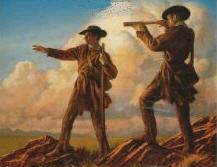
|
"We set out early and proceeded on..." |

|
"We set out early and proceeded on..." |
|

|
The Journals
Captains Clark and Lewis and at least four others in the party each kept a journal, making entries on many days during the journey. They are full of stories of daily labors, incidents, adventures, and discoveries; they have character and immediacy, and they are the primary resource for the history of the expedition. "The Journals of the Lewis and Clark Expedition are not just a daily log of one of history's most significant journeys. They are also a treasure of American literature, in company with Moby Dick, Leaves of Grass, Walden, and Huckleberry Finn. ... Woven through the Journals are many important lessons. ... The writings of Meriwether Lewis and William Clark and their subordinates can be read on many levels: as adventure narrative, as travelogue, as scientific field notes, as history-making, as essays, and as a report to the President, which was their original purpose. But they can also be read as American folk literature... full of flavor and wonder, humor and quaintness, windows not only into the time, but also into the minds and personalities of the authors themselves. And like most great American literature, they remain unread by most Americans, even though there is not an American whose life hasn't been affected by the expedition and its outcomes." -- James Alexander Thom, in Author's Note to Sign-Talker. "These journals are a national literary treasure. Lewis and Clark's exploration of the western two-thirds of the continent was our epic voyage, their account of it is our epic poem. Sitting before the nightly campfire, using a quill pen that had to be dipped into the inkwell every other word, balancing their leather-covered journals on their knees, Captains Meriwether Lewis and William Clark described the day's events, as well as the land and its people and its flora and fauna, in a prose remarkable for its terse, sharp imagery, tension, and immediacy." - Stephen Ambrose. Abridged Journals
Five journals by expedition members survive, totaling something like one million words.
The complete journals fill nine volumes. There are many different abridgments printed
in single volumes. You can choose
a version with "corrected" spelling, punctuation, and grammar, or not.
The unaltered accounts offer
excitment and vividness lacking in the revised versions, and I strongly urge you to try it,
although some people find the irregular spelling an obstacle to understanding.
Their spelling is often phonetical and is a guide to how they sounded when they spoke.
One abridgement of the journals that I recommend is
The Journals of Lewis and Clark, Frank Bergon, editor
(Penguin Books, 1989). It is not "corrected" and is small a paperback you can take hiking or in a canoe.
Another good choice for a pocket-sized edition is
The Journals of Lewis and Clark, edited by John Bakeless (Signet Classics, 2002).
Also notable is The Lewis and Clark Journals An American Epic of Discovery.
Gary E. Moulton, editor (University of Nebraska, 2003), a large hardback abridgement of the
complete journals in 13 volumes prepared by Moulton, described below.
The introduction by Moulton is an excellent short history of the expedition).
Other abridgements are edited by Anthony Brandt
(National Geographic, 2002) and Landon Y. Jones (Ecco Press, 1999).
The Complete Journals
The Journals of the Lewis and Clark Expedition 13 volumes.
by Meriwether Lewis, William Clark, and others; Gary E. Moulton
(editor). Lincoln: Univ of Nebraska Press, 1983-2001.
"The definitive work for our
time." "...one of the major scholarly achievements of the late twentieth century."
Includes extensive explanatory notes on all subjects.
If you cite journal passages for any reason it should be from this edition; all previous editions of the complete journals are obsolete!
Also includes the journals of the the other expediton writers such as Floyd, Gass, Ordway, and
Whitehouse, and a volume on the L&C herbarium (plant collections), and a
volume of maps.
You might consider asking your library to find these with
Inter-Library Loan, considering the number and cost.
The hard-bound edition is expensive, but Nebraska has issued the same books in much
less expensive paperback editons of the same size, see The Definitive Journals
described below.
The University of Nebraska Press is putting the Gary Moulton edition of the journals online, for free.
The University of Nebraska Press is publishing the core of the Moulton Journals in eight paperback volumes,
at a very low cost for what you receive.
Before the Gary Moulton edition of all of the journals, and the abridgements noted above, the journals were
only available in the edtions prepared by Elliott Coues in 1893 and Reuben Gold Thwaites in 1904. While
these editions were once essential, now they have little to offer except for some special uses.
Journal Illustrations
Lewis and Clark each occasionally made sketches in their journals.
The American Philosophical Society has a comprehensive online listing
of illustrations that appear in the Lewis and Clark journals and related items in the collections of
the American Philosophical Society, the Missouri Historical Society,
and the Beinecke Library (Yale). This listing includes "low resolution scans
of all images held by the APS, along with selected images of the journals
themselves, ilustrations associated with Lewis and Clark and the Corps of Discovery,
and a small selection of journal entries. Images held by MHS or Yale are listed, but not displayed."
Copies of APS illustrations in a variety of formats are available for a range of fees.
Click here to see The American Philosophical Society's illustrations from the Journals.
| |||||||||||||||
|
|
||||||||||||||||